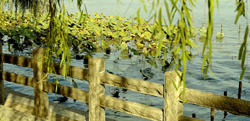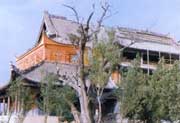Gallery of Philologists
Tswei Shu
19 Sept 1740 (Da-ming) - 4 Mar 1814Tswei Shu predates the international effort which we usually call Sinology. Had he worked in a different social context, he might now be esteemed as the Ranke (1795-1886) of his tradition, and not merely as one of its precursors. Instead, his work was obscure during his lifetime, little known or lost after his death, and rediscovered only in recent years. Its implications are still to be absorbed by historians of China.
Tswei Shu was born into a scholarly family in 1740, in the vicinity of Da-ming, and competed unsuccessfully for the highest degree in 1762. In 1764 he married Chvng Jing-lan, herself an educated woman with scholarly aspirations, from one of the leading families of Da-ming. In 1769 he again competed unsuccessfully for a degree, and thereafter resigned himself to life as a village schoolmaster. He and his brother Tswei Mai had together investigated the authenticity of the "Old Script" portions of the Shu, but in their isolation they did not know of other work along those lines, and did not themselves became known to contemporaries. Tswei Mai died in 1781. Tswei's Shu's masterpiece, the comprehensive study of antiquity which he called Kau-syin Lu, was begun in 1783. He served as an editor of a history of Da-ming commissioned by its magistrate in 1784. The portion of Kau-syin Lu dealing with Confucius was completed in 1791. He took it with him to the capital in 1792 when competing yet again for a degree in the hope of alleviating family poverty. There he showed it to a new acquaintance, Chvn Li-hv, who was so impressed that from that moment, though the two never met again, Chvn dedicated himself to making Tswei's work known, sacrificing in the process his own hopes of career advancement.
Beginning in 1796 Tswei took up a series of positions as a local magistrate, arousing official resentment in each by his skill and honesty in dealing with local corruption, but consistently sustained by higher authority. Wishing to devote himself to his studies, in resigned in 1802 from his current position. He and his wife lived out their remaining years in poverty, sometimes pawning clothes to buy food, and working on his manuscripts. From a distance, Chvn Li-hv labored to have those works printed, a few in 1805 and one more in 1808. Tswei himself had one work printed in 1801 and three more in 1806-1810. He became incapacitated in 1813. His wife died in 1814. In 1815, sensing that the end was near, he composed a table of contents for his whole output; it included 34 works. He died in 1816. Chvn Li-hv was able to print only 19 works before he himself died, leaving an official debt and a son aged five. The rest of the works are lost. Naka Michiyo reprinted the surviving items in 1904 from a copy preserved in Japan. Chinese interest was not aroused until Hu Shr's essay "Tswei Shu as a Scientific Historian of Antiquity" appeared in 1923. Gu Jye-gang issued a definitive edition of the works, including some recently rediscovered writings in prose and verse by Tswei Mai, in 1936.
Even before the age of 20, Tswei Shu had begun to doubt the authenticity of certain Analects passages, and he and his brother went on to challenge the spurious "old script" Shu documents. At thirty, he had concluded that the accounts of remote antiquity written in Chin and Han were often at variance with the accounts in the classics; this led to his celebrated discovery that the ancient emperor lore had been built up in reverse, with successively later texts giving more and more information about earlier and earlier mythical emperors. His series of works on ancient history, begun in 1783, had the collective title Kau-syin Lu: they aimed to investigate (kau) which works within the tradition could be trusted (syin) as an account of the Chinese classical past. They constitute by far the most extended scrutiny ever given, in traditional China, to the alleged classical foundations of traditional China. His demonstration that the last five chapters of the Analects are later than the rest of the work added a third layer to the previously perceived two has been a particularly influential result. The point for philology is that not only has the distribution of suspect features here been observed, but their implication for the formation of the text has been drawn.
It is sometimes objected, as it is also objected in the case of Ranke, that Tswei did not pursue far enough the path which his work had marked out for historians in general, or even mark that path clearly enough. Among other things, it has been said that, while being properly suspicious of Han and Warring States accounts, Tswei Shu remained too credulous toward the texts of the canonical tradition. Such criticisms are easy enough to make from atop the platform of careful scholarship which Tswei Shu himself erected. If a genuinely scientific account of the classical corpus is ever achieved (and as of the beginning of the 21c, this is still a future prospect), it will rest on the foundation laid in the 18c by Tswei Shu.
Readings
- Gu Jye-gang (ed). Tswei Dung-bi Yi-shu. 1936; repr Shanghai Guji 1986
- Hu Shih. Kvsywe dv Gushrjya Tswei Shu ["Tswei Shu as a Scientific Historian of Antiquity"] (1923), in Tswei Dung-bi Yi-shu 953
- Hu Shih et al. Tswei Shu dv Nyenpu ["Chronology of Tswei Shu"], in Tswei Dung-bi Yi-shu 956-1014
- Arthur Hummel. Eminent Chinese of the Ch'ing Period. The substantial entry on Tswei Shu, the basis for the present profile, is by Hummel.
- Shao Dongfang. Cui Shu (1740-1816): His Life, Scholarship, and Rediscovery. UMI 1994
- Shao Dongfang. Learning and Meaning: Cui Shu's Historical Epistemology. JCP v22 #3 (Sept 1995) 309-344
- Michael Quirin. Scholarship, Value, Method, and Hermeneutics in Kaozheng: Some Reflections on Cui Shu (1740-1816) and the Confucian Classics. History and Theory Theme Issue 35 (December 1996) 34-53
- Shao Dongfang. Tswei Shu yw Junggwo Syweshu-shr Yenjyou ["Tswei Shu and Chinese Intellectual History"]. Rvnmin 1998
1 Dec 2005 / Contact The Project / Exit to Gallery Index Page

